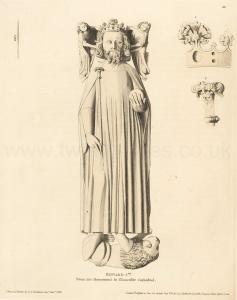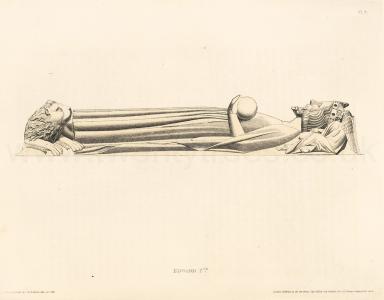Effigy of King Edward II
Effigy of King Edward II is in Monumental Effigies of Great Britain.
THE fourth son of King Edward the First and Eleanor his Queen, was born at Caernarvon [Map], in North Wales, April 25th, 1284, from which circumstance he derived his surname. After the death of Llewelyn ap Griffith, he was created Prince of Wales, being the first of the elder sons of the Kings of England who bore that title. He was also Earl of Ponthieu and Chester, and succeeded his father in his Kingdoms 7th July, 1307, being then twenty-three years of age. His father, just before his death, had banished from the country Piers de Gavaston, a Gascon gentleman of light and prodigate habits, who had corrupted his principles. On his death-bed he laid a curse on him if ever he recalled him; directed him to carry his body with him into Scotland; not to bury it until he had subjugated that country, and to send his heart to the Holy Land. One of the first acts of his reign was, in spite of this injunction, to recall Gavaston from exile, to invest him with the Earldom of Cornwall, and other large possessions of the Crown. The chief officers and judges of the land were dismissed from their posts to make way for the favourites of this Court minion. Edward gave him in marriage Margaret, his own niece, being the child of Gilbert de Clare, Earl of Gloucester, by Joan of Acre, daughter to Edward the First; and on setting out for Boulogne, in 1308, to celebrate his marriage with Isabella, daughter of the King of France, he appointed him Custos of the Realm in his absence.


The deportment of the favourite, and the blind partiality of the King, so disgusted the Barons, that, under the direction of Thomas Earl of Lancaster, his cousin, they came to a resolution to oblige the King to banish Gavaston from England for life: with which dictation Edward found himself obliged nominally to comply. However, instead of dismissing him in fact from his counsels, and from office, he appointed him Lieutenant of Ireland, and shortly after recalled him to his Court. A repetition of similar circumstances at length incensed the people, the Barons, and their leader, Thomas Earl of Lancaster, to the highest pitch. An army was levied in order to seize the person of Gavaston, who was protected by the King. He lodged him in Scarborough Castle [Map]; where, after some resistance, he was forced to surrender, and was shortly afterwards executed on Blacklow-hill, near Warwick, by the confederate nobles, by a kind of summary military sentence. The next remarkable event of King Edward's reign was his signal defeat in Scotland by Robert Bruce, at the battle of Bannockburn, on Midsummer day 1314.
The King's inclination for favouritism was not to be corrected by the fate of Gavaston. Hugh Spenser, his Chamberlain, succeeded to the place which he had held in the King's affections, became equally obnoxious to the Barons, and, with his father, who had been created Earl of Worcester [Note. Earl of Winchester], and had shared with his son in the fruits of the King's favour, was banished from the Realm by a decree of Parliament, exacted by the confederate nobles sword in hand. The Spensers, however, shortly afterwards returned to England. The King's party was successful in their turn, and Thomas Earl of Lancaster, the leader of the Barons, was defeated, made prisoner, and beheaded at Pontefract [Map], his own Castlea, 22d March, 1322.

Note a. He was the son of Edmund Crouchback, whose tomb has been described.
His Queen Isabella, who was in France with her paramour Mortimer and the young Prince Edward, now instituted a series of intrigues against her husband. She inflamed the minds of the English people against their monarch, and, aided by William Earl of Hainault and Holland, fitted out an expedition to invade his dominions, under the plausible pretence of ridding the nation of its burthens, and reforming the Government. The King fled into Wales; the elder Spenser was besieged in Bristol [Map], taken, hanged without trial, his body cut to pieces and thrown to the dogs: this in the ninetieth year of his age. The King himself was shortly after captured in the monastery at Neath, in South Wales, with the younger Spenser, who was hanged at Hereford [Map] on a gibbet fifty feet high, furnished expressly for the occasion by the citizens of London.



The Queen and Mortimer now proceeded to procure a formal deposition of the King by the Parliament. The King acceded to their decree, communicated by certain commissioners, delegated for the purpose. Judge Trussel pronounced, in the name of the Bishops, the Barons, and the people of England, all allegiance to him void. The High Steward of the Household broke his staff, and declared all officers discharged from his service. Thus was the political demise of this unfortunate King attended by the same ceremony which had consigned his predecessors to the grave!

He was at first committed to the custody of Henry Earl of Lancaster, his cousin, who treating him with too much lenity, Thomas Lord Berkeley, John Maltravers, and Sir Thomas Gournay, were constituted his keepers in rotation. He was transferred from castle to castle, poorly clothed; and on one occasion Maltravers commanded him to be shaved with water from a neighbouring ditch, when bursting into indignant tears, he exclaimed, "Here is at least warm water on my cheeks, whether you will or not!" The eyes of the people began now, however, to be opened to just consideration, and their hearts to relent in favour of their liege lord. The Queen and Mortimer saw that, even from his miserable existence, if protracted, might accrue vengeance for their own heads. They therefore send orders to Gournay and Maltravers for his death; a command too promptly and cruelly obeyed by those instruments of hell, who in the absence of Lord Thomas Berkeley from his Castle [Map], entered the King's chamber at dead of night, threw him on his bed, and introduced a red-hot iron through a horn into his body. The ancient walls of the Castle [Map], the neighbouring town of Berkeley, and the shores of the Severn Sea, resounded with his dying shrieks! The peasant was aroused from the tranquil slumber so little known to the royal couch, and uttered a prayer for the passing soul of his Kinga.


Note a. See Holinshed, fol. edit. vol. H. p. 344.
Thus says the poet, in allusion to this event:
"Mark the year and mark the night.
When Severn shall re-echo with affright.
The shrieks of Death through Berkeley's roofs that ring.
Shrieks of an agonizing King!
She-wolf of France, with unrelenting fangs
Thou tears't the bowels of thy mangled mate!"
The manner of his death obviated all show of external violence in the general appearance of his person. His body was conveyed without pomp to Gloucester Cathedral [Map], where the monument hearing the effigy represented in the plates was afterwards erected by his son Edward the Thirda. He had by his wife Isabella four children:—Edward of Windsor, who succeeded him; John of Eltham,—both of whom will be noticed in their places; Joan, wife of David Bruce, afterwards King of Scotland; Eleanor, who became the second wife of Reynold Earl of Geldres.

Note a. He is said to have made some Latin verses while in prison, describing his calamities, declaring his submission to them as a punishment for his grievous sins, and imploring mercy for them through the merits of his Redeemer, and the intercession of the blessed Virgin. These are paraphrased at length in Fabian's Chronicle. (Reprint, p. 431.)

